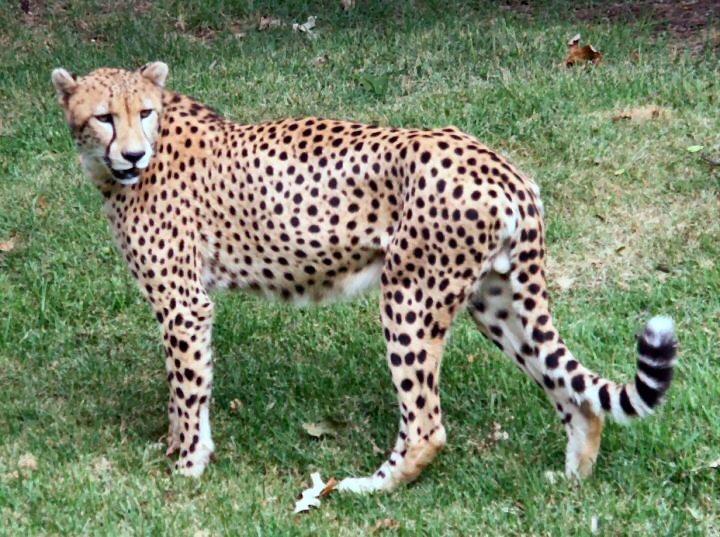CHEETAH
|
CHEETAH
|
 |
| Name: Cheetah |
| Scientific name: Acinonyx jubatus |
| Geographic Range: subsaharan Africa and Northern Iran |
| Habitat: Open grassland with many elevated points |
| Status: Endangered |
| Diet in the wild: small antelope - springbok, steenbok, duikers, impala and gazelle; young warthogs, kudu, hartebeest, oryx, roan and sable; also game birds and rabbits |
| Diet in the zoo: Carnivorous Diet |
| Location: Cheetah Exhibit |
| General
Information
"Cheetah" comes from a Hindi word meaning "spotted one." Two groups exist in wild populations: the family group and males. Males, often siblings, form a group of 2 or 3; rarely 1 will live alone. This group will live and hunt together for life and claims a range which may overlap several female territories. Male territories may be as large as 300 square miles. Young females, however, usually occupy the same range as their mother although all females are solitary except when they have a litter. Males and females mix only to mate; the males do not participate in cub-raising. Following a gestation period about 93 days a litter may contain 2 to 8 cubs. At birth cubs are about 12 inches long and weigh about 0.6 pounds. They are gray color with a mantle of hair along the back, which helps camouflage the cub in grass, but it begins to disappear at 3 months. Only a small number reach adulthood: lions and hyenas are their worst enemies. The mother moves the cubs every few days to avoid those predators. The young stay with the mother for 16-24 months. Cheetahs are the fastest animals on land - able to reach speeds of up to 80 miles per hour for short bursts. They use their speed for hunting instead of relying on stealth and strength like many other species of big cats. The cheetah is carnivorous, eating a variety of small animals. While most cats are nocturnal predators, the cheetah is diurnal, hunting in early morning and late afternoon. It likes to scan the countryside from a tree or the top of a hill because the cheetah is dependant on sight rather than smell. The cheetah chases its prey for about 3.5 miles at an average speed of 45 miles per hour. The stalk is as important as the sprint; usually it will try to get within 50 yards of its prey before the final acceleration. Full sprints last about 20 seconds and almost never exceed 1 full minute. The cheetah suffocates its captive, closing its jaw about the animals windpipe and squeezing until its dead. At 6 weeks the young are strong enough to participate with the hunt. Cheetah driven off its kill
(Africam)
Cheetahs are often persecuted by other predators, who steal their food, eat their cubs, and even attack the adults. For these reasons, cheetahs life span in the wild is about 4 to 5 years, but they have been to known to live up to 15 years in zoos. The cheetah is considered the most endangered big cat today. Human excess is probably the major factor pushing the cheetah toward extinction. Too many people squeeze out other species, robbing them of living space and limiting their food supply. Other contributing factors to their extinction include illegal hunting and low genetic variability. Some scientists believe that the cheetah population was nearly destroyed 10,000 years ago by a catastrophic event such as a disease or natural disaster that left only 1,000 or so surviving . In 1900 there were approximately 100,000 cheetah worldwide. Present estimates place their number at 10-15 thousand with about 1/10 of those living in captivity. Namibia has the largest population of cheetah - about 2500. Smaller populations exist in about 25 other countries - once ranging from Africa through central Asia all the way to India. |
|
Reference list for cheetahs:
University of Michigan Animal Diversity page on cheetahs:
Natural History Museum of Los Angeles page on cheetahs:
The Cheetah Spot:
|
| Page author:
Paul Baker
E -mail: paulbaker2@hotmail.com WhoZoo contact: mac@whozoo.org |
|
Source of information: Fort Worth
Zoo, Encyclopedias, Books, and the Internet
|